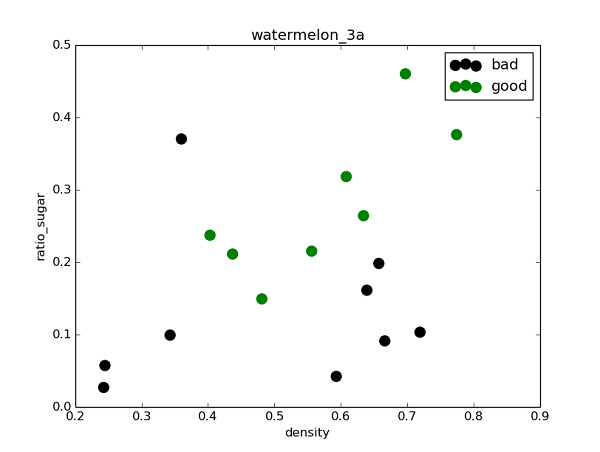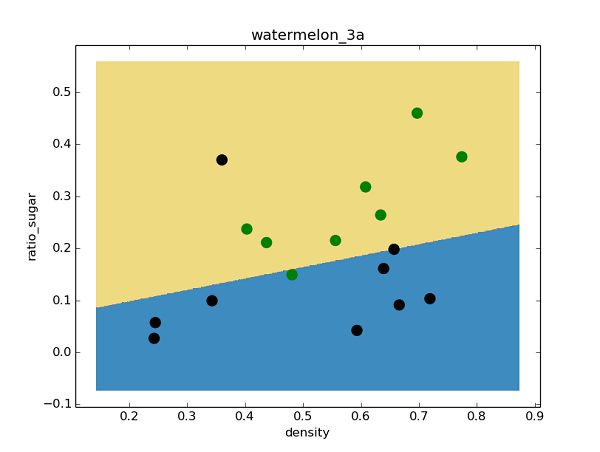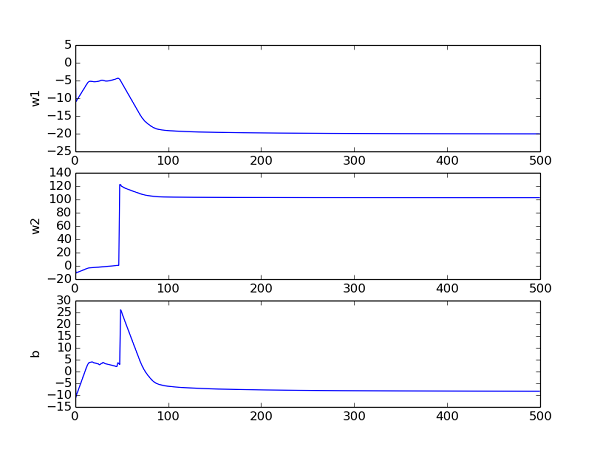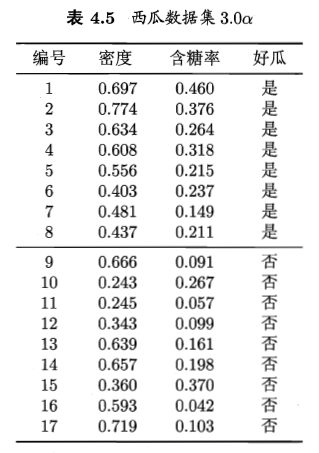本题是本书的第一个编程练习,基于sklearn库函数、独立编程两种方式实现了对率回归(即逻辑斯蒂回归-LR)模型。
这里的程序基于Python实现,相关答案和源代码托管于我的Github:PnYuan/Machine-Learning_ZhouZhihua,欢迎访问。
题目
所使用的数据集如下:
本题是本书的第一个编程练习,采用了自己编程实现和调用sklearn库函数两种不同的方式,详细解答和编码过程如下:(查看完整代码和数据集):
获取数据、查看数据、预处理
观察数据可知,X包含(密度、含糖量)两个变量,y为西瓜是否好瓜分类(二分),由此生成.csv数据文件,在Python中用Numpy读取数据并采用matplotlib库可视化数据:
样例代码:
1 | ''' |
采用sklearn逻辑回归库函数直接拟合
虽然样本量很少,这里还是先划分训练集和测试集,采用sklearn.model_selection.train_test_split()实现,然后采用sklearn.linear_model.LogisticRegression,基于训练集直接拟合出逻辑回归模型,然后在测试集上评估模型(查看混淆矩阵和F1值)。
样例代码:
1 | ''' |
得出混淆矩阵和相关度量(查准率(准确率)、查全率(召回率),F1值)结果如下:
[[4 1]
[1 3]]
precision recall f1-score support
0.0 0.80 0.80 0.80 5
1.0 0.75 0.75 0.75 4
avg / total 0.78 0.78 0.78 9
由混淆矩阵可以看到,由于样本本身数量较少,模型拟合效果一般,总体预测精度约为0.78。为提升精度,可以采用自助法进行重抽样扩充数据集,或是采用交叉验证选择最优模型。
下图是采用matplotlib.contourf绘制的决策区域和边界,可以看出对率回归分类器还是成功的分出了绝大多数类:
自己编程实现逻辑斯蒂回归
编程实现逻辑回归的主要工作是求取参数w和b(见书p59),最常用的参数估计方法是极大似然法,由于题3.1已经证得对数似然函数(见书3.27)是凸函数,存在最优解,这里考虑采用梯度下降法来迭代寻优。
回顾一下Sigmoid函数,即逻辑斯蒂回归分类器的基础模型:
目的是基于数据集求出最优参数w和b,最常采用的是极大似然法,参数的似然函数为:
根据书p59,最大化上式等价于最小化下式:
题3.2已证上式为凸函数,一定存在最小值,但按照导数为零的解析求解方式较为困难,于是考虑采用梯度下降法来求解上式最小值时对应的参数。
注:梯度下降法基本知识可参考书中附录p409页,也可直接采用书中p60式3.30偏导数公式。书中关于参数迭代改变式子如下:
对于迭代,可每次先根据(B.16)计算出梯度▽f(β),然后由(B.17)更新得出下一步的Δβ。
接下来编程实现基本的梯度下降法:
(1)首先编程实现对象式3.27:
1 | def likelihood_sub(x, y, beta): |
(2)然后基于训练集(注意x->[x,1]),给出基于3.27似然函数的定步长梯度下降法,注意这里的偏梯度实现技巧:
1 | ''' |
通过追踪参数,查看其收敛曲线,然后来调节相关参数(步长h,迭代次数max_times)。下图是在当前参数取值下的beta曲线,可以看到其收敛良好:
(3)最后建立Sigmoid预测函数,对测试集数据进预测,得到混淆矩阵如下:
[[ 4. 1.]
[ 1. 3.]]
可以看出其总体预测精度(7/9 ≈ 0.78)与调用sklearn库得出的结果相当。
(4)采用随机梯度下降法来优化:上面采用的是全局定步长梯度下降法(称之为批量梯度下降),这种方法在可能会面临收敛过慢和收敛曲线波动情况的同时,每次迭代需要全局计算,计算量随数据量增大而急剧增大。所以尝试采用随机梯度下降来改善参数迭代寻优过程。
随机梯度下降法的核心思想是增量学习:一次只用一个新样本来更新回归系数,从而形成在线流式处理。
同时为了加快收敛,采用变步长的策略,h随着迭代次数逐渐减小。
给出变步长随机梯度下降法的代码如下:
1 | def gradDscent_2(X, y): #implementation of stochastic gradDscent algorithms |
得出混淆矩阵:
[[ 3. 2.]
[ 0. 4.]]
从结果看到的是:由于这里的西瓜数据集并不大,所以随机梯度下降法采用一次遍历所得的结果不太好,参数也没有完成收敛。这里只是给出随机梯度下降法的实现样例,这种方法在大数据集下相比批量梯度法应会有明显的优势。
参考链接
由于这是本书第一个编程,索引资料较多,择其重要的一些列出如下:








